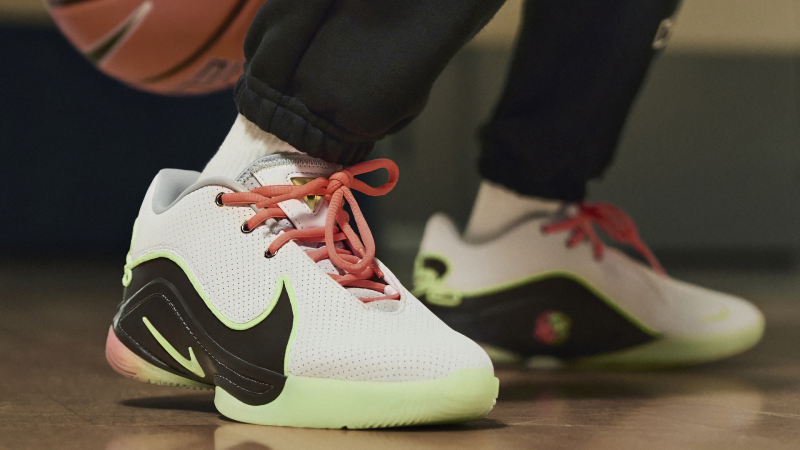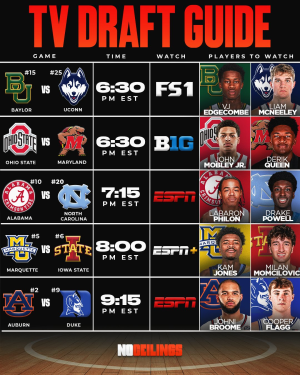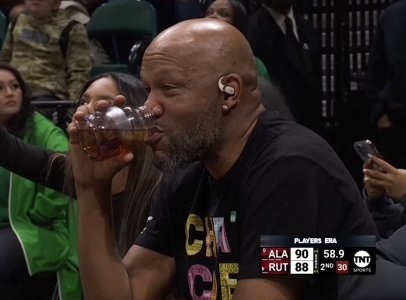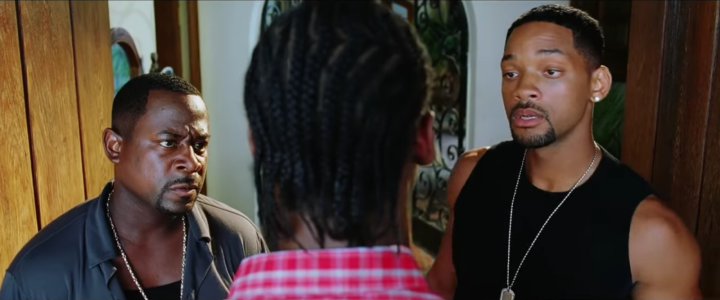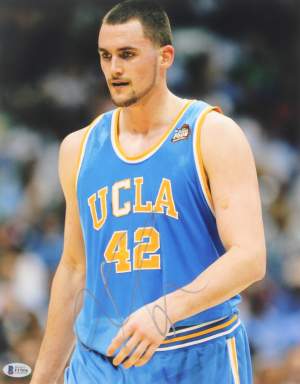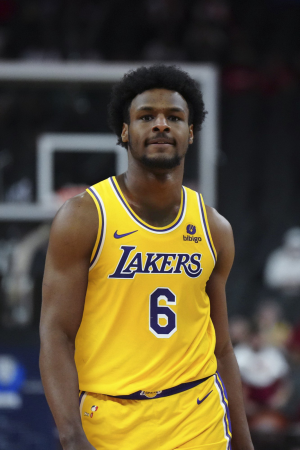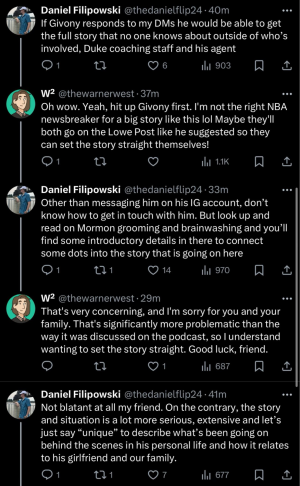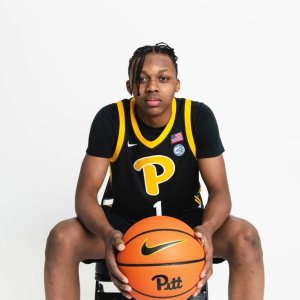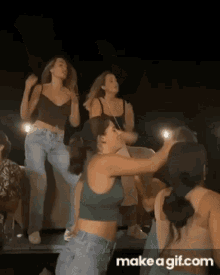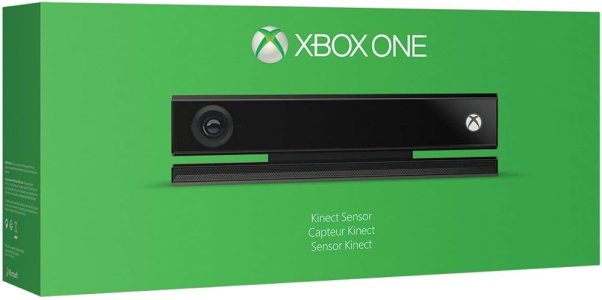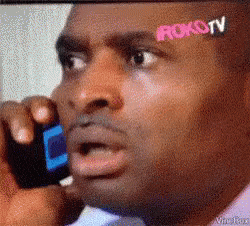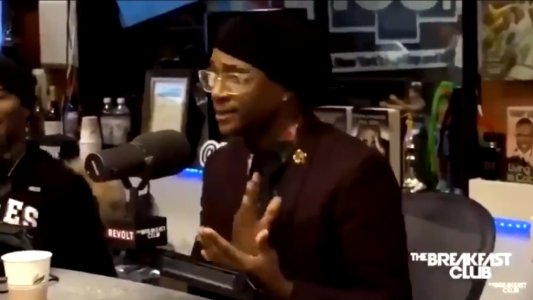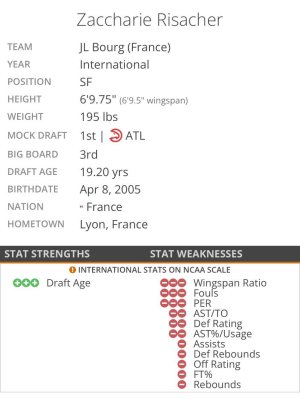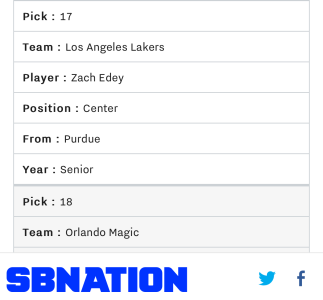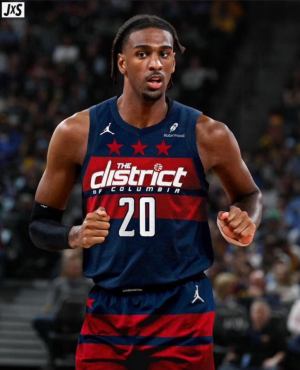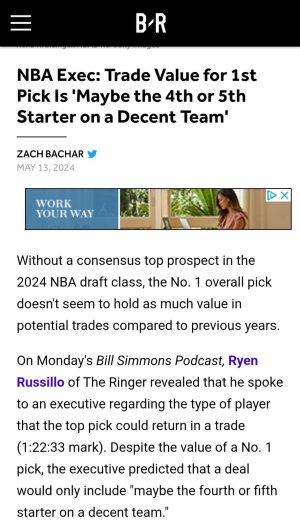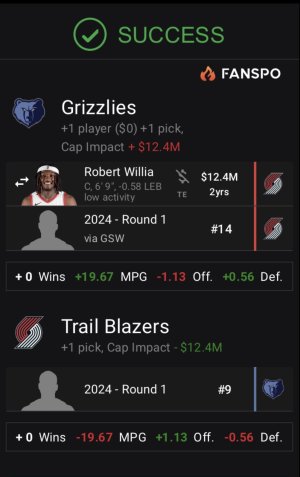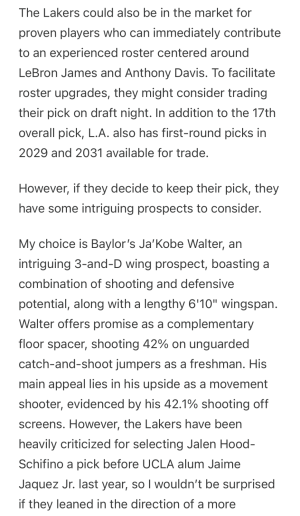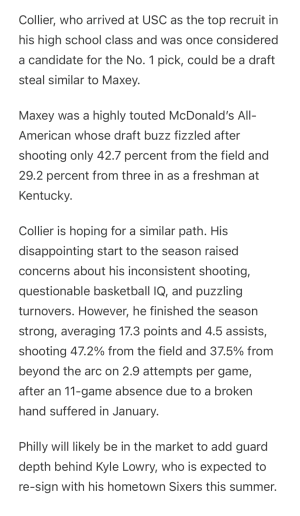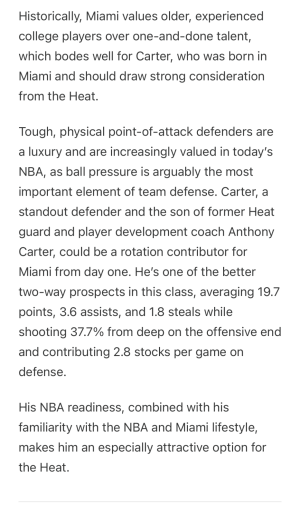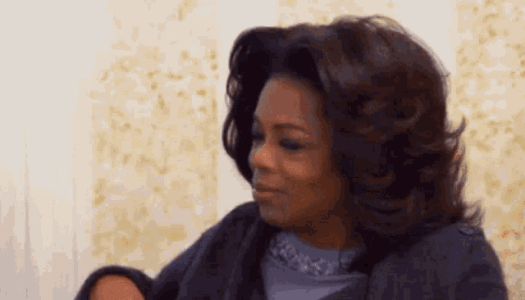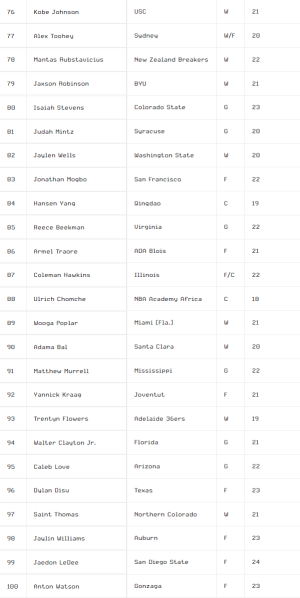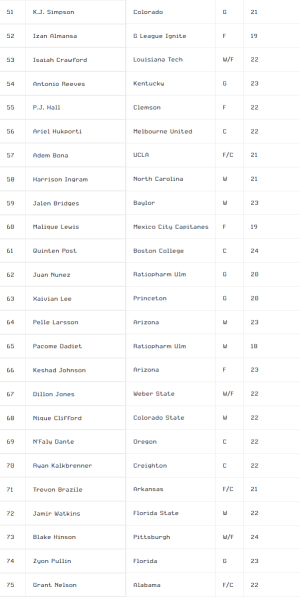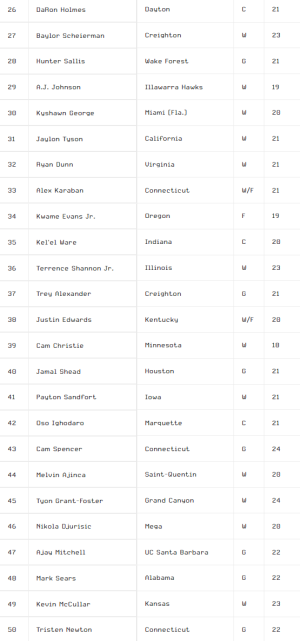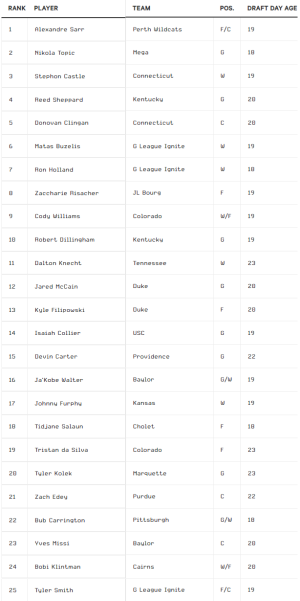2024 NBA draft rankings: Jonathan Givony's top 100 prospects
1. Zaccharie Risacher | SF | Bourg (France)
6-foot-10 | Age: 19.1 | Previously ranked: 1
Risacher's Bourg team advanced to the French playoff semifinals, where they'll face No. 1 seed Monaco, a top-level Euroleague team that should provide a staunch challenge. Risacher had a career-best 28-point outing in Game 2 of the quarterfinals, putting his talent as a dynamic 6-10 shot-maker and versatile defender with an elite feel for the game on full display.
Risacher is in a group of prospects firmly in the mix for the Atlanta Hawks at No. 1, sources say, and likely won't have to wait long to hear his name called as he's in consideration for every team picking in the top 5. Risacher is slated to attend the NBA Global Camp in Treviso, Italy starting June 4 where he'll go through combine-style testing, drills, interviews and medical examinations; though that might not materialize if Bourg advances to the finals. Risacher is expected to be selective with his pre-draft visits among NBA suitors once he finally does make his way to the States. -- Givony
2. Alex Sarr | PF/C | Perth (Australia)
7-1 | Age: 19.0 | Previously ranked: 2
Sarr was ESPN's top-ranked prospect to appear at the combine, and is on the shortlist of options for the Hawks at No. 1 overall. He opted not to do a pro day in Los Angeles, typical for a top-pick candidate, but it remains to be seen at this time which teams he will work out for going into draft night. His upside is arguably the highest of any of the draft's prospects because of his considerable physical profile (measuring just under 7-foot barefoot at the combine with a 7-4.25 wingspan and 9-foot-2 standing reach). He has unusual mobility for his size.
In addition to considerable defensive potential, Sarr has the makings of a versatile offensive skill set, capable of running the floor and finishing plays, occasionally putting the ball on the floor, and with some shooting touch out to the arc. He still has development ahead of him in order to harness his abilities -- leaving some room for potential downside if he doesn't progress as expected for a high pick -- but the blueprint for an impactful starting-caliber player is there. -- Woo
3. Donovan Clingan | C | UConn
7-2 | Age: 20.2 | Previously ranked: 3
Clingan has momentum going into June, as he made a strong impression in the drills portion of the combine, private interviews and his pro day, where he dropped intriguing glimpses of perimeter shooting that many scouts feel will be part of his game in the not-too-distant future. His measurements -- 7-3 in shoes, 282 pounds with a 7-7 wingspan and outrageous 9-7 standing reach are elite (as we already knew).
The draft lottery did not do him too many favors, though, slating teams with entrenched starters at the center position at Nos. 3, 4 and 5, which might drop him a little further than his big-board ranking indicates. It would not be surprising to see teams such as the Portland Trail Blazers or the Memphis Grizzlies try to move up on draft night to snag their starting center of the future. There is some chatter, however, that Clingan has fans among the Hawks' constituency at No. 1, meaning there's a lot left to be played out between now and June 26. -- Givony
4. Reed Sheppard | PG/SG | Kentucky
6-3 | Age: 19.9 | Previously ranked: 7
Sheppard measured a little bigger than expected at 6-3 in shoes while testing a 42-inch vertical leap in Chicago. He also looked like the clear-cut best shooter in the draft every time he had a ball in his hands -- both at the combine and his pro day in Los Angeles this week. Several teams have said that Sheppard's statistical profile -- with his incredible scoring efficiency (56% FG%, 52% 3P%, 83% FT%) combined with his excellent steal, block and passing metrics -- have him ranked as the No. 1 prospect in their draft models, something that surely has caught the attention of analytically inclined front offices, such as the Houston Rockets.
With the premium that NBA teams are increasingly placing on perimeter shooting, it's hard to see Sheppard dropping below the top 5, with his fit in San Antonio alongside Victor Wembanyama looking especially strong at the Spurs' No. 4 pick. -- Givony
5. Matas Buzelis | SF | G League Ignite
6-10 | Age: 19.6 | Previously ranked: 6
Buzelis didn't participate in an agency pro day in Chicago, but based on what we saw from him in private workout settings, he should have opportunities to help his standing in the coming weeks. He offers some of the prototypical qualities teams are looking for at forward, with solid positional size, vertical bounce, developing offensive versatility and better defensive acumen than scouts were expecting entering this season.
His production at the G League level portends room for growth; he settled in as the season went on, flashed shot-making ability and contributed in a range of areas. It's going to take Buzelis some time, and he'll need to continue packing strength onto his frame to handle both forward positions long-term, but there's a baseline here for a very useful NBA player, and upside for more than that if a team can be patient with him. -- Woo
6. Stephon Castle | PG/SG | UConn
6-7 | Age: 19.5 | Previously ranked: 9
Castle measured out better than expected in Chicago at a hair under 6-7 in shoes, and shot surprisingly well in drills, hitting 18-for-25 3-pointers in the star shooting drill, tied for third best at the combine. NBA teams were hoping to see him replicate that performance at his pro day, but he elected to sit it out. After playing mostly as a complementary wing option for national champions UConn, Castle has told teams in private interviews he views himself as a point guard in the NBA.
He also appears to be avoiding private workouts with teams that already have starting point guards in place, a strategy that might not be as effective as in the past since every team in the top-15 has his medicals because of rule changes implemented this year. -- Givony
7. Rob Dillingham | PG | Kentucky
6-2 | Age: 19.3 | Previously ranked: 4
Dillingham is nearing a return to team workouts in mid-June as he recovers from an ankle injury that held him out of testing at the combine. There's considerable upside and downside to selecting Dillingham early in the draft. He's one of the best available shot-creators, with shiftiness and plus-shooting capability off the bounce. But his physical traits (he stands just over 6-2 in shoes, 164 pounds, with a 6'3 wingspan) traditionally haven't fared well for NBA success, and render him a negative defender.
His offensive gifts give him a chance to pan out as a full-time starter, but the drawbacks could make him better suited for a sparkplug role off the bench, which isn't what teams are hoping for in a top-10 pick. The nature of the 2024 draft class has made Dillingham a consideration for teams at the top of the draft, but he remains a polarizing player among scouts. -- Woo
8. Dalton Knecht | SG/SF | Tennessee
6-6 | Age: 23.0 | Previously ranked: 8
Knecht is set to complete his unlikely climb from an older, off-the-radar prospect to a top-10 pick, with teams viewing him as a bankable wing scorer who is ready to contribute minutes in the NBA right away. He brings legit positional size at 6-6 in shoes with a 6-9 wingspan, three-level scoring ability and the skill set to be a shooting threat playing off the ball.
Knecht isn't going to be a very good defender, at least not immediately. But his lack of high-level experience prior to landing at Tennessee, as well as his impressive production there, creates a degree of intriguing upside, even for a prospect who's already 23 years old. Teams expect him to come off the board in the lottery. -- Woo
9. Nikola Topic | PG | Red Star (Adriatic League)
6-7 | Age: 18.7 | Previously ranked: 5
Topic's season ended with a knee injury suffered in the Adriatic League Finals, his second in this calendar year, a development that will be studied closely by teams once NBA doctors are able to conduct a thorough physical examination. Several teams have pointed out that European doctors often have different philosophies from their American counterparts regarding ligament injury treatment as well as their likelihood for recommending surgery. So it's all but a certainty that his MRIs will be scrutinized closely and might have an impact on his draft stock if his availability for next season comes into question.
Topic's playmaking prowess -- as a 6-7 pick-and-roll maestro with possibly the fastest processing speed of any prospect in this draft -- should help overcome those question marks, as he was gaining momentum for consideration as one of the draft's top prospects before his season was derailed. -- Givony
10. Tidjane Salaun | PF | Cholet
6-10 | Age: 18.7 | Previously ranked: 15
Following a strong stretch of play to end his season in France, Salaun has created real lottery momentum going into June. A 19-point, eight-rebound showing against a quality Paris team in the playoffs helped highlight his considerable potential. He showcased his physicality, 3-point shooting and competitive motor, which all bode well for his chances of eventually filling a valuable role at the next level.
Salaun, who turns 19 on Aug. 10, offers untapped ability and a strong baseline for a combo forward at the NBA level, though it might take another year or two for him to emerge as a consistent contributor. It's hard to find players in any draft with his combination of qualities, which should help to stabilize him as an early selection in this class. With his season over, he will measure and participate in drills and interviews in the NBA Global Camp in Treviso, Italy next week before making his way to the U.S. for team workouts. -- Woo
11. Ron Holland | SF | G League Ignite
6-8 | Age: 18.8 | Previously ranked: 13
Holland measured bigger than expected at the combine -- nearly 6-8 in shoes with a 6-11 wingspan and 38-inch vertical leap, comparable to NBA players such as Andrew Wiggins, Jayson Tatum and Herbert Jones. Teams were hoping to see Holland show a little more progress with his perimeter shooting than what they saw at the combine or his pro day, making him somewhat of a situational fit for certain lottery teams that are grappling with surrounding their existing players with ample spacing.
The fact Holland is young -- he turns 19 on July 7 -- productive and boasts dynamic two-way versatility bolsters his cause, giving him much to gain over the next month as the heart of pre-draft workouts start. -- Givony
12. Cody Williams | SG/SF | Colorado
6-8 | Age: 19.5 | Previously ranked: 10
Williams, at this stage, will need strong showings on the workout circuit to solidify himself as a lottery pick because a month out, he might be more ticketed for the Nos. 10-to-20 range. His difficult finish to the season hurt his momentum as a top-10 prospect. He did have strong flashes of scoring, playmaking and perimeter defense. He fits the bill physically for an NBA wing, standing nearly 6-8 with a 7-1 wingspan.
Williams has to get stronger and develop all areas of his offensive game, particularly his outside shooting. He is still quite young and offers more physical potential than some of the other project-type players in the draft. The potential mix of his size and two-way versatility still makes him a worthwhile swing, albeit he has become a more polarizing player than expected early in the season. -- Woo
13. Devin Carter | PG/SG | Providence
6-4 | Age: 22.1 | Previously ranked: 17
Carter has significant momentum as he's in the midst of an outstanding month that has him knocking on the door of the draft lottery. He measured well and tested as arguably the best athlete in this draft at the combine, posting historic figures that included a 42-inch vertical leap and shuttle and sprint times that put him in elite company. Carter also had one of the best pro day showings we saw in either Chicago or Los Angeles, putting his Olympic-level athletic ability on full display and knocking down 30-foot pull-up jumpers with ease, as he did all season at Providence.
Teams looking for immediate backcourt help, starting with the San Antonio Spurs at No. 8 and the Memphis Grizzlies at No. 9 have significant interest in Carter, as his draft stock may continue to climb in the next month as he gets into private workouts. -- Givony
14. Ja'Kobe Walter | SG/SF | Baylor
6-5 | Age: 19.7 | Previously ranked: 12
Walter was projected early in the season as a lottery pick, but appears to have settled more in the Nos. 10-to-20 range as the draft draws closer. His combination of shooting ability and plus length (6-10 wingspan) for a two-guard give him a reasonable chance to become a useful 3-and-D contributor at the NBA level.
He struggles at times to create his own shot off the bounce, which might limit him somewhat considering he is not extraordinarily quick or tall for his position. His freshman year numbers weren't overwhelming, but Walter's skill set and intangibles make sense for a useful off-ball role long-term -- and there's security in what he brings to the table. -- Woo
15. Jared McCain | PG/SG | Duke
6-3 | Age: 20.2 | Previously ranked: 19
McCain gradually crept up draft boards this season, emerging as Duke's best backcourt player and flashing his ability as a shot-making guard who can play with or without the ball comfortably. Teams view McCain as the type of player who should be able to compensate for his average size and athleticism with skill and versatility in the long run.
It remains to be seen whether he can grow into point guard-level usage at the NBA level or winds up as more of a complementary off-guard. There are feasible pathways for him to become a contributor either way, thanks to his shooting ability, feel and considerable work ethic and intangibles. -- Woo
16. Zach Edey | C | Purdue
7-5 | Age: 22.0 | Previously ranked: 14
Edey replicated his absurd measurements from last year's combine -- standing 7-5 in shoes with a 7-11 wingspan and 9-7 standing reach. He also showed off the progress he has made in several facets in drills, athletic testing and his pro day, where NBA teams were pleasantly surprised to see him take part in significant competitive action. Edey has trimmed down seven pounds from last year and tested out better in every athletic testing drill, showing the gains he has made with his mobility and explosiveness. He also shot the ball well from beyond the arc, an area Edey insists will be part of his offensive arsenal in the future.
Several NBA teams mentioned being impressed with his serious-minded approach in interviews, where he discussed the joy he takes in punishing opponents with his physicality, a trait that was readily apparent on film. Edey has fans in the top 10, but also plenty of detractors, creating a somewhat wide range that extends into the 20s, depending on how the draft shakes out. -- Givony
17. Tristan Da Silva | SF/PF | Colorado
6-9 | Age: 23.0 | Previously ranked: 18
The level of versatility Da Silva provides at his size should make him a useful and appealing option for teams with immediate needs, which helps to firm up his range, likely in the top 20. He can play both forward spots as a floor-spacer and ball-moving option on the perimeter, standing over 6-foot-9 in shoes.
He began to really tap into that ability this past season at Colorado, helping answer prior questions about his consistency and toughness. He has put himself on an attractive trajectory where he should be able to provide minutes early in his pro career, and continue to better utilize his size to his own benefit. -- Woo
18. Johnny Furphy | SG/SF | Kansas
6-9 | Age: 19.4 | Previously ranked: 28
As the NCAA's withdrawal deadline approaches, teams have indicated Furphy has only worked out for spots in the lottery. His decision whether to return to Kansas will likely go down to the wire, depending on how the coming days go and whether he likes his options. Scouts have been intrigued by Furphy's mix of size, skill and smooth athleticism, particularly at his age and early stage of physical development.
He looked good in workout settings at the combine and shoots it well already, with the main questions being how much better he can get defensively (an area where he struggles) and how much his body might progress. He should be an attractive upside swing for a team, whether it's this year or next year's draft. -- Woo
19. Kyshawn George | SG/SF | Miami
6-8 | Age: 20.4 | Previously ranked: 24
George measured well at the combine, with similar dimensions to NBA small forwards such as Joe Ingles and DeMarre Carroll. Although his late-blooming pathway as a prospect likely means he is another season or two away from seeing significant NBA minutes, George has the skill level to deploy his size at multiple positions. Teams are always attracted to big wings who can handle, pass and shoot and slot in all over the floor, and while it requires some projection, George has solidified first-round appeal.
The biggest questions stem from his struggles attacking the paint and handling physicality at this stage -- a deficiency that might stem from his lack of high-level experience prior to college. George will likely be asked to work some of that out in the G League next season, but he fits a valuable mold, and should make for an intriguing upside swing. -- Woo
20. Kyle Filipowski | PF/C | Duke
7-0 | Age: 20.5 | Previously ranked: 16
Filipowski has work to do over the next month in solidifying his draft standing, as some teams have expressed skepticism after uneven showings in combine drills and private interviews. On one hand, every NBA team is looking for a 7-footer who can handle, pass and space the floor while displaying defensive versatility, something that was on display all season at Duke and also at his pro day where he had some strong moments.
On the other, Filipowski's nerves got the best of him in Chicago, especially in shooting drills where he struggled at times, leaving him plenty of work to do to regain momentum in private workouts. -- Givony
21. Isaiah Collier | PG | USC
6-4 | Age: 19.6 | Previously ranked: 11
Listed at 6-5 by USC, Collier measured smaller than expected at the combine, at a hair under 6-4 with a 6-5 wingspan. He did not alleviate concerns around his lack of perimeter shooting in drills. He then also sat out his pro day, which was an opportunity to showcase himself in a different light with decision-makers on hand from every NBA team.
Teams say it's unclear how much competitive action they'll be able to see from Collier in pre-draft workouts, which might create a somewhat wide range on draft night. Few prospects share the shot-creation prowess, scoring instincts and star power Collier boasts, but he'll have to find the right team willing to live through the growing pains that come with empowering him with significant ballhandling responsibility after his uneven freshman campaign. -- Givony
22. Carlton Carrington | PG | Pittsburgh
6-5 | Age: 18.8 | Previously ranked: 25
Carrington measured well in Chicago -- 6-foot-5 in shoes, 195 pounds and a 6-8 wingspan -- impressive numbers considering he won't turn 19 until July 21. He shot the ball well in drills, but left something to be desired at his slow-paced pro day. Carrington has NBA fans already late in the lottery thanks to his combination of size, shot-making prowess and passing creativity.
He has much to gain in competitive action in private workouts over the next few weeks, where he can try to show NBA teams he's more prepared to contribute than he's currently being given credit for. -- Givony
23. Yves Missi | C | Baylor
7-0 | Age: 20.0 | Previously ranked: 20
Standing nearly 7-feet in shoes with a 7-foot-2 wingspan and 9-1.5 standing reach, Missi has legit tools for a center, although he'll likely need some time to fully tap into them. He should be able to fill a useful rim-running mold as a rebounder, low-usage scorer, screener and paint protector, but will need further seasoning to get up to NBA-level processing speed.
Lingering questions about his feel and skill level give him a somewhat narrow pathway to an eventual role. Still, his physical profile will always have appeal, which has put him in the first-round conversation as a development project. -- Woo
24. Bobi Klintman | SF/PF | Cairns
6-10 | Age: 21.2 | Previously ranked: 23
Klintman helped himself at the combine by measuring just under 6-foot-10 in shoes and showing off his gregarious personality in interviews, which several teams cited as being among their favorite interactions in Chicago. Every NBA team is looking for oversized wings with athleticism, perimeter shooting ability, transition scoring prowess and defensive versatility.
Klintman can further solidify his draft stock over the next month by showing how his talent translates to productivity in competitive workouts, where scouts still have some questions about his consistency on both ends of the floor. -- Givony
23. Kel'el Ware | C | Indiana
7-0 | Age: 20.0 | Previously ranked: 27
With a dearth of big-men prospects, teams drafting in the bottom half of the second round are closely studying the candidacy of Ware, who has plenty of things going for him with his tremendous size (7-1 in shoes), length (7-4.5 wingspan), reach (9-4.5), mobility and productivity on both ends of the floor.
Ware has done a good job of addressing some of the red flags in his profile from his time at Oregon with stronger than expected interviews and background intel, helping to solidify his standing in the first round. Like most players in this range, Ware's workouts will be key. -- Givony
Nos. 26-100
26. Baylor Scheierman, SG,/SF, Creighton
27. Tyler Smith, SF/PF, G League Ignite
28. Justin Edwards, SG,/SF, Kentucky
29. Tyler Kolek, PG, Marquette
30. Kevin McCullar Jr., SF Kansas
31. Terrence Shannon Jr., SG,/SF, Illinois
32. Ryan Dunn, SF/PF, Virginia
33. Jaylon Tyson, SG,/SF, California
34. Cameron Christie, SG, Minnesota
35. AJ Johnson, SG, Illawarra
36. Alex Karaban, PF Connecticut
37. Juan Nunez, PG, Ratiopharm Ulm
38. Pacome Dadiet, SG,/SF, Ratiopharm Ulm
39. Nikola Djurisic, SG,/SF, Mega MIS
40. Adem Bona, C, UCLA
41. Ulrich Chomche, PF/C, NBA Academy Africa
42. Jonathan Mogbo, PF/C, San Francisco
43. Harrison Ingram, SF/PF, North Carolina
44. Ajay Mitchell, PG, UC Santa Barbara
45. Pelle Larsson, SG, Arizona
46. Payton Sandfort, SF Iowa
47. Dillon Jones, SF/PF, Weber State
48. Izan Almansa,PF/C, G League Ignite
49. Melvin Ajinca, SG,/SF, Saint Quentin
50. Keshad Johnson, PF Arizona
51. KJ Simpson, PG, Colorado
52. DaRon Holmes II, PF/C, Dayton
53. Jamal Shead, PG, Houston
54. Bronny James, PG,/SG, USC
55. Hunter Sallis, SG, Wake Forest
56. Jalen Bridges, SF Baylor
57. Oso Ighodaro, PF/C, Marquette
58. Ariel Hukporti, C Ludwigsburg
59. Isaac Jones, PF/C, Washington St
60. Jaylen Wells, SG,/SF, Washington St
61. Enrique Freeman, PF/C, Akron
62. Cam Spencer, SG, Connecticut
63. Antonio Reeves, SG,/SF, Kentucky
64. Trentyn Flowers, SG,/SF, Adelaide
65. Mantas Rubstavicius, SF NZ Breakers
66. Jaxson Robinson, SG,/SF, BYU
67. Trevon Brazile, PF/C, Arkansas
68. Ugonna Onyenso, C Kentucky
69. PJ Hall, PF/C, Clemson
70. Trey Alexander, PG,/SG, Creighton
71. Quinten Post, C Boston College
72. Armel Traore, PF Blois
73. Zacharie Perrin, PF/C, Antibes
74. Jamir Watkins, SG,/SF, Florida St
75. Michael Ajayi, SF/PF, Pepperdine
76. Baba Miller, SF/PF, Florida St
77. Matthew Murrell, SG, Mississippi
78. Tristen Newton, PG,/SG, Connecticut
79. Coleman Hawkins, PF Illinois
80. Mark Sears, PG, Alabama
81. Isaiah Crawford, SF/PF, Louisiana Tech
82. Riley Minix, SF/PF, Morehead St
83. Tyon Grant-Foster, SG,/SF, Grand Canyon
84. JT Toppin, PF New Mexico
85. Anton Watson, PF Gonzaga
86. Jarin Stevenson, PF Alabama
87. Nae'Qwan Tomlin, PF/C, Memphis
88. Jesse Edwards, C West Virginia
89. Nique Clifford, SG, Colorado St
90. Reece Beekman, PG, Virginia
91. N'Faly Dante, C Oregon
92. Malique Lewis, SF/PF, Mexico City
93. Andrija Jelavic, PF/C, Mega MIS
94. Judah Mintz, PG,/SG, Syracuse
95. Yannick Kraag, SG,/SF, Joventut
96. Ilias Kamardine, PG,/SG, Vichy-Clermont
97. Walter Clayton, PG, Florida
98. Dylan Disu, PF Texas
99. Tre Mitchell, PF/C, Kentucky
100. Boogie Ellis, PG,/SG, USC
![Alien 0] 0]](/styles/default/xenforo/NTemojis/alien.gif)


 could be ticketed for an NBA-friendly campaign.
could be ticketed for an NBA-friendly campaign.